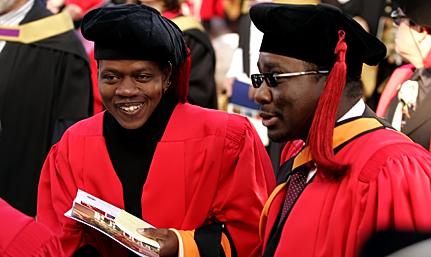|
 |
28 June 2013
Photo: Johan Roux |
The way to immortalise a person, is to live by his example. PhD and master's graduates were imbued by the following message from Dr Khotso Mokhele, Chancellor of the University of the Free State (UFS), during the UFS Winter Graduation Ceremony: to follow Nelson Mandela's majestic example is to guarantee that his life was not in vain.
Dr Mokhele honoured the graduates for their achievements "that clearly did not come easy", referring to the sacrifices on their part and the role of their support structures.
He also praised members of the UFS' leadership team who contributed academically to the excellent standards. Prof Teuns Verschoor, former Vice-Rector: Institutional Affairs, and Prof Driekie Hay, Vice-Rector: Academic, were especially mentioned for their role as respectively co-promoter and promoter of two PhD graduates.
A total of 63 doctorates and 414 master's degrees were awarded to graduates from South Africa, Nigeria, Lesotho, Uganda and Zimbabwe on Thursday 27 June 2013.
On the previous day, the School of Open Learning kicked off the graduation event by conferring 320 qualifications.
The graduates, most of them full-time educators, received qualifications ranging from certificates to diplomas.
"I hope that you will plough back what you have learned and that this qualification will make you a better educator, an inspired one, one that will relentlessly put your efforts into increasing a better future for our children," Prof Hay said, highlighting challenges in South Africa's education system.
"Become enthused, obsessed and passionate to change the education system. Be the change agent in your schools to contribute in giving the quality education our children so desperately need," she said.
An exceptional moment at this year's graduation ceremony was when the two daughters of an academic, Prof Dave Lubbe of the Centre for Accounting, obtained their master's degrees. "It is indeed a highlight in my career that my daughters received their master's degrees cum laude at the same graduation ceremony, under my supervision!"
Prof Lubbe's two daughters, Nandi Lubbe and Leandi Steenkamp, both received their MCom with distinctions in Accounting. They completed their degrees under the supervision of Prof Lubbe and Nandi also won the Dean's medal as the best M student in the Faculty of Economic and Management Sciences.